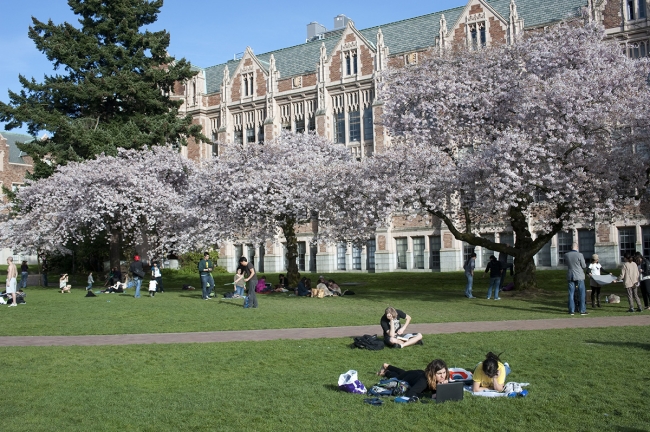You have /5 articles left.
Sign up for a free account or log in.

The Washington Student Achievement Council will use its grant to inform SNAP-eligible high schoolers of their financial aid options for attending college, including at the University of Washington’s Seattle campus, pictured above.
Photo by Wolfgang Kaehler | LightRocket via Getty Images
Given the ambiguous future of standardized testing, troubles with FAFSA and the impact of the Supreme Court’s ban on race-based admissions—all unfolding in the shadow of the enrollment cliff—college admissions are at an inflection point. That’s why the Lumina Foundation decided to offer higher education institutions funding to rework their admissions processes.
Launched last fall, the Great Admissions Redesign awards grants to governmental offices and higher ed systems looking to make admissions simpler and more accessible. Lumina targeted the effort at systems, agencies and groups—rather than individual institutions—because officials wanted to support initiatives that would be far-reaching and “pre-scaled,” according to Melanie Heath, strategy director for participation at Lumina.
At first, Heath worried that the “abbreviated” application window Lumina offered might yield few candidates, but 71 entities applied, she said; seven were chosen to receive grants.
“That kind of blew me away because it felt really exciting to see so many states and systems and institutions are really thinking differently about how we can do admissions and the entire onboarding process into college,” she said.
Three of the winners were awarded $750,000 implementation grants for programs that have already been tested and are ready to be scaled up; the remaining four received smaller planning grants. The winning projects vary significantly: The Washington Student Achievement Council, for instance, intends to develop a system to inform SNAP-eligible high schoolers in the state about the robust financial aid available to them. In Texas and Illinois, higher education leaders plan to create tools to implement direct admissions—the increasingly popular program in which students are guaranteed admission to an institution based on grades or other metrics.
Winning Projects
Kentucky Student Success Collaborative received a planning grant, which leaders said they will use to conduct a robust analysis of the admissions processes at the state’s eight public universities to determine how to increase the number of high schoolers in the state who go on to earn a postsecondary credential.
That could include figuring out how to facilitate the transition to college for Kentucky’s many dual-enrollment high school students, or making it easier for students to compare cost across the eight universities. The collaborative also plans to look into how artificial intelligence can be used in admissions.
“The exact strategy that we plan to implement, we will identify and co-create with our campus partners,” said the collaborative’s executive director, Lilly Massa-McKinley.
The Louisiana Board of Regents also received a planning grant, which it will apply to three different projects: creating a statewide network of student success organizations; establishing a direct admissions framework; and expanding the state’s universal transfer pathways, which ensure community college students’ coursework will count toward their credential at any Louisiana four-year institution.
The board, in partnership with hundreds of faculty members across the state’s universities, has already established 24 universal transfer pathways as of last year. The grant will help secure about 20 more, according to Tristan Denley, deputy commissioner for academic affairs and innovation.
Trends in Admissions Innovation
Many trends emerged among the applications for the award, Heath said. The most popular topic for proposals was direct admissions; she estimated about 80 percent of the applicants sought the funds at least in part to implement a direct admissions program.
The model is so popular that some states are looking to build on existing direct admissions frameworks to create more opportunities to connect prospective students with universities. One of the winners, the Illinois Board of Higher Education, will use its $750,000 grant to build on its direct admissions infrastructure and create a system for community college students seeking to transfer into a four-year institution. It will be the first statewide direct admissions program targeted at community college transfers in the country, according to Lumina.
Heath also noticed that state higher education offices are becoming more and more involved in admissions; 16 of the applications came from those offices.
“Admissions has typically been thought of as solely within the purview of the institution but what we’ve seen with this is admissions is being seen more and more as a state … issue,” she said.
Heath lauded the originality and diversity of the grant-winning initiatives.
“They’re all so different,” she said. “There’s so much to be learned from each project.”




